Placeholder: What is the next era of blockchain after DeFi?
Original Title: Onchain Finance Is Thriving; What's Next?
Original Author: Mario Laul
Decentralized public blockchain networks have existed for about 15 years, and the associated crypto assets are currently experiencing the fourth major market cycle. Over the years, especially since the launch of Ethereum in 2015, we have spent a significant amount of time and resources building theories and developing applications based on these networks. While the progress of these networks in financial use cases has been remarkable, other types of applications have struggled primarily due to the complexity of providing scalable and smooth user experiences under the constraints of "decentralization," as well as the fragmentation of different ecosystems and standards. However, recent technological advancements have made applications, both within and outside the blockchain industry, not only more feasible but also more necessary than ever before.
The early adoption of blockchain was driven by a rather narrow definition of its core functionality: the secure issuance and tracking of digital assets without relying on centralized intermediaries such as traditional finance or government institutions. Whether we are talking about blockchain-native fungible tokens like BTC and ETH, the on-chain representation of off-chain assets such as national currencies and traditional securities, or non-fungible tokens (NFTs) representing artworks, game items, or any other type of digital products or collectibles, blockchain tracks these assets and allows anyone with an internet connection to trade them globally without touching centralized financial rails. Given the scale and importance of the financial industry, particularly in the context of increasing digitization, globalization, and financialization, this alone is enough to demonstrate that blockchain is a highly revolutionary technology and to attract global attention.
Within this narrow framework, in addition to the underlying asset ledgers and the decentralized networks that maintain them, there are currently five blockchain applications with significant product-market fit: applications for issuing tokens, applications for storing private keys and transferring tokens (wallets), applications for trading tokens (including decentralized exchanges, DEX), applications for lending tokens, and applications that provide predictable value for tokens relative to traditional fiat currencies (stablecoins). As of the writing of this article, the number of crypto assets listed on the crypto market data aggregator Coingecko has exceeded 13,000, with a total market capitalization of approximately $2.5 trillion and daily trading volume exceeding $10 billion. Nearly half of this value is concentrated in a single asset, BTC, while the majority of the other half is distributed among the top 500 assets. However, the long tail of tokens is extensive and continues to grow, especially after NFTs have been included, indicating the significant market demand for blockchain as a digital asset ledger.
According to recent statistics, approximately 420 million people globally hold crypto tokens, although many of them may have never or rarely interacted with decentralized applications. A report from hardware wallet manufacturer Ledger shows that its Ledger Live software has about 1.5 million monthly active users, while software wallet providers MetaMask and Phantom claim approximately 30 million and 3.2 million monthly active users, respectively. Combined with daily DEX trading volumes of about $5-10 billion, approximately $30-35 billion in locked value in the on-chain lending market, and about $130 billion in stablecoin market capitalization, these figures indicate that the current adoption level of the aforementioned five types of applications is still quite low compared to traditional finance and fintech, but remains significant. Admittedly, these numbers should be considered in the context of the recent surge in crypto asset prices, but as blockchain regulation becomes more refined (with the approval of spot Bitcoin ETFs and tailored regulatory frameworks like Europe’s MiCA), they may continue to attract new capital and users, especially in the context of increasing integration with traditional financial assets and institutions.
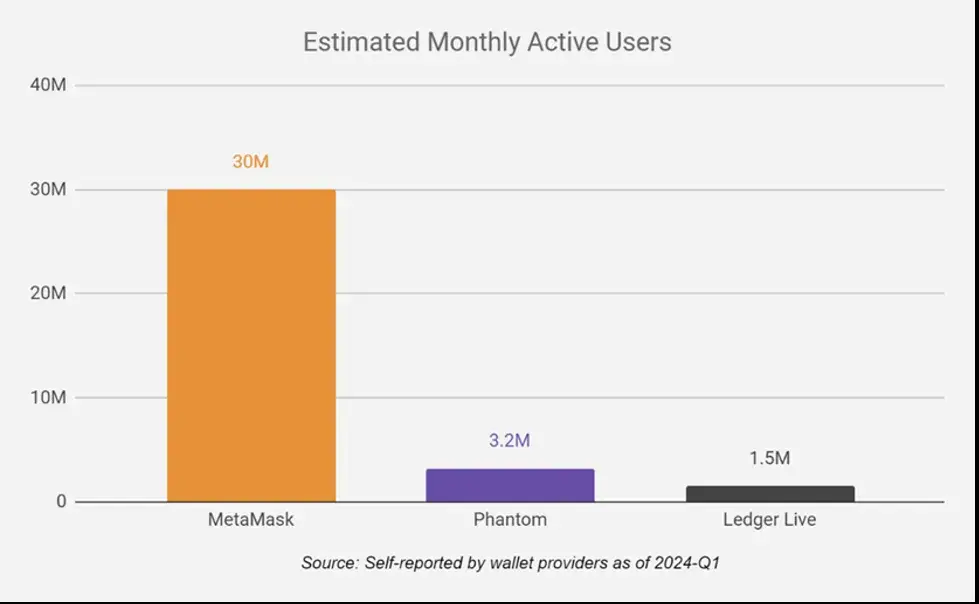
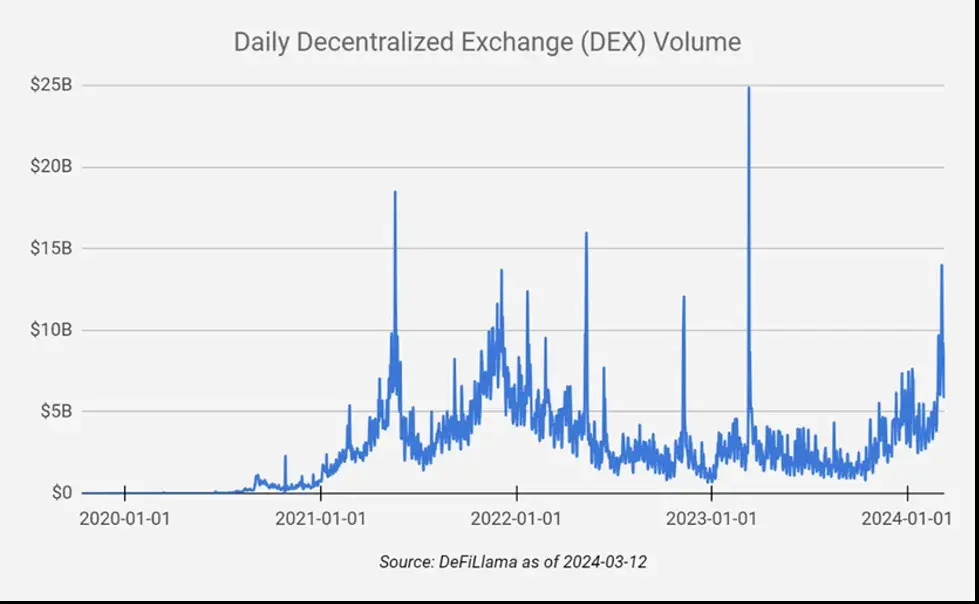
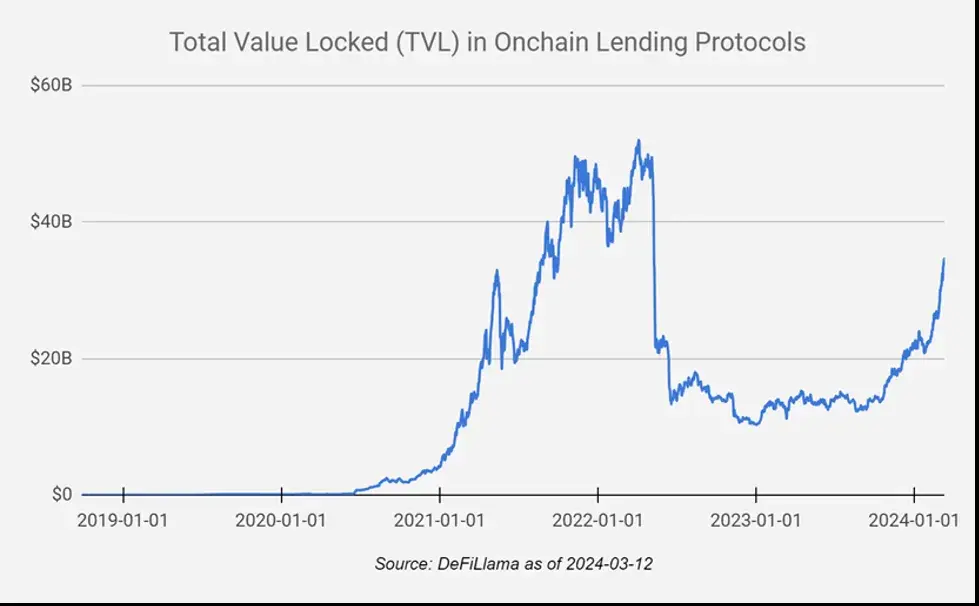
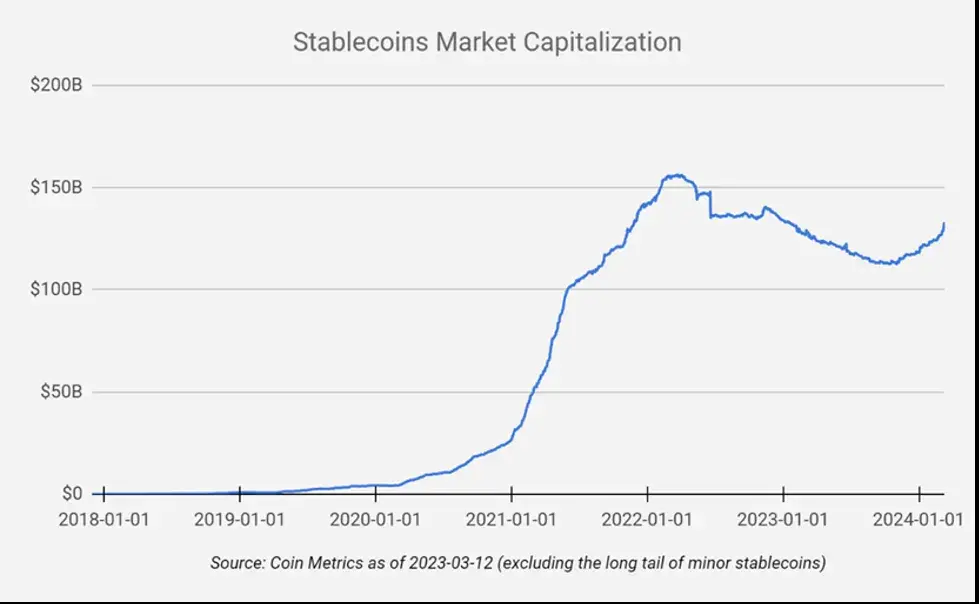
However, financial applications such as tokens, wallets, DEX, lending, and stablecoins are just the tip of the iceberg for applications that can be built on general-purpose programmable blockchains. Measuring blockchain adoption should not be limited to its narrow role as an enhanced asset ledger but should be placed in a broader context, such as a more general alternative to centralized databases and web application platforms. The number of global developers is currently approaching about 30 million; however, according to Electric Capital's latest Crypto Developer Report, the number of monthly active developers on public blockchains is still less than 25,000, with only about 7,000 in full-time roles. These numbers indicate that blockchain currently has a significant gap in attracting developers compared to traditional software platforms. However, the number of developers with at least two years of crypto development experience has been increasing for five consecutive years, with contributors in various ecosystems exceeding 1,000. Additionally, over the past 6-7 years, crypto has attracted more than $90 billion in venture capital. While the vast majority of this funding has indeed been used to build underlying blockchain infrastructure and core decentralized finance (DeFi) services (which are considered the pillars of the emerging on-chain economy), it also indicates a significant interest from capital in non-financial, utility-focused application areas, such as online identity, gaming, social networks, supply chains, the Internet of Things, and digital governance, among others. So, how successful are these types of applications in the most mature and widely used smart contract blockchains?
There are three main metrics that can indirectly measure market interest in specific blockchains and applications: daily active addresses, daily transaction volume, and daily fee expenditure. Before interpreting these metrics, it is important to understand that they can easily be artificially inflated, so these data can only serve as a very rough estimate. According to data from the on-chain data aggregator Artemis, over the past 12 months, six networks have stood out in all three metrics (each network ranking in the top six in at least two metrics): BNB Chain, Ethereum, NEAR Protocol, Polygon (PoS), Solana, and TRON. Four of these networks (BNB, Ethereum, Polygon, TRON) utilize the Ethereum Virtual Machine (EVM), thus benefiting from the universality of Solidity (the programming language created for EVM) tools and network effects. NEAR and Solana both have their own native execution environments, primarily based on Rust, which, while more complex, offers various performance and security advantages compared to Solidity, and has a thriving ecosystem outside the blockchain industry.
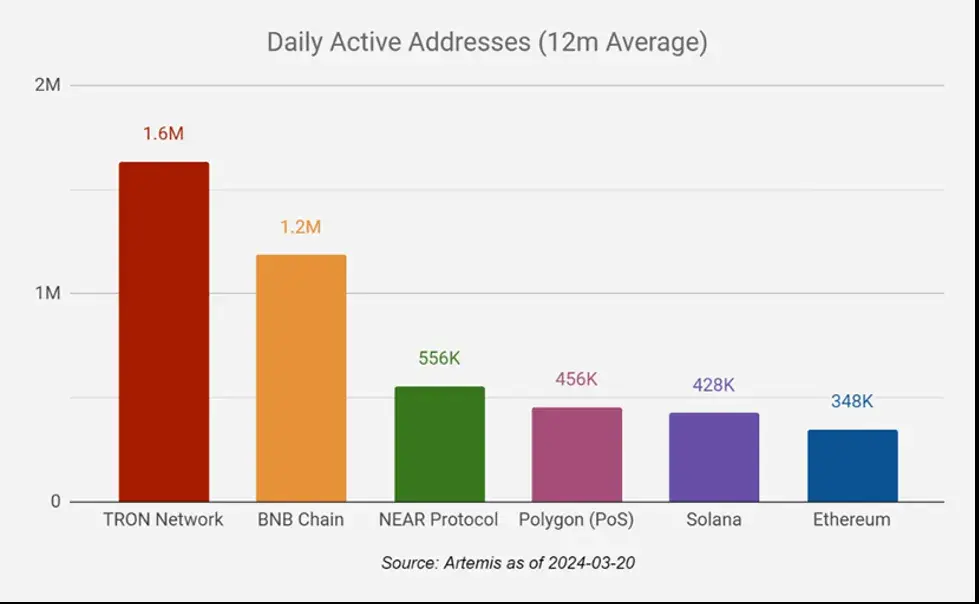
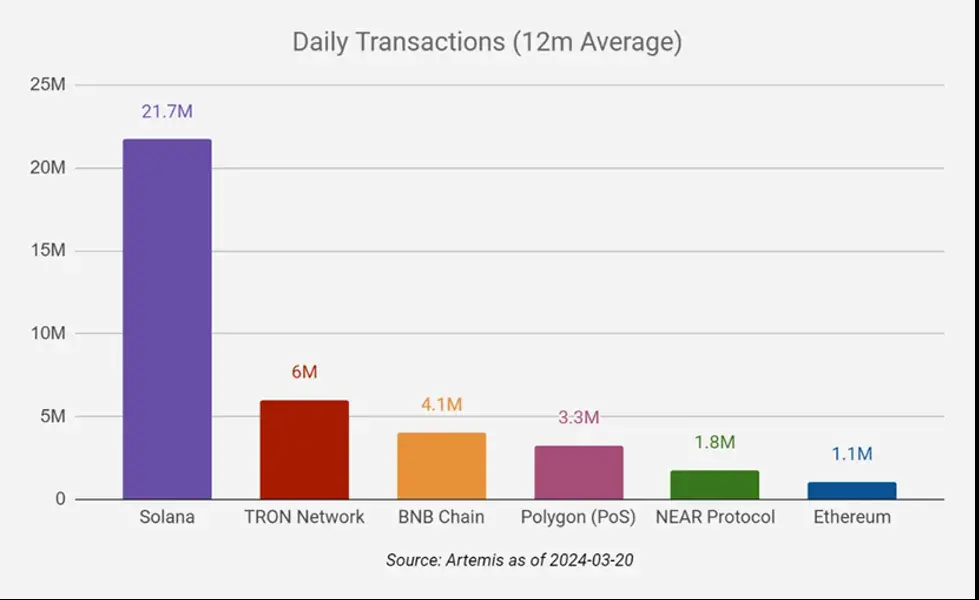
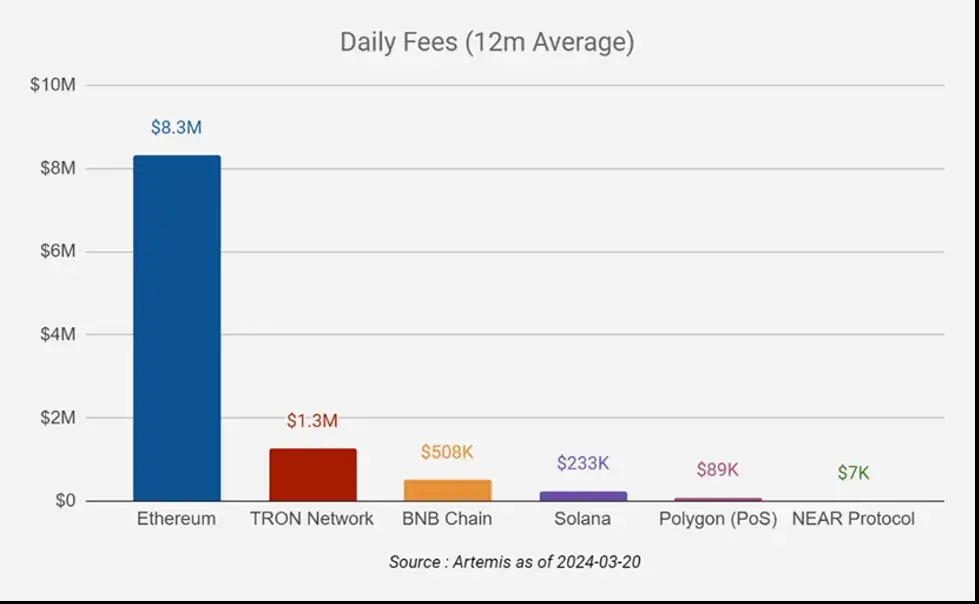
All six networks' on-chain activity is concentrated in the top 20 applications, with daily active addresses for applications ranked beyond the top 20 (inaccurate data) dropping to thousands or even hundreds, depending on the network. As of March 2024, on an average day, the top 20 applications account for 70-100% of the three metrics considered, with Tron and NEAR showing the highest concentration, while Ethereum and Polygon show the lowest. Across all networks, the top 20 applications are primarily those related to tokenization, wallets, and DeFi (exchanges, lending, stablecoins), with very few or almost no applications outside of these categories (0-4 per network). Aside from bridges used to transfer value between different blockchains and NFT marketplaces (both of which should be included in the asset transfer and exchange categories), the remaining few outliers are typically games or social applications. However, in five out of the six cases, the share of applications in overall network activity is very low; for example, Polygon's best data is less than 20%, but usually below 10%. The only exception is Near, but its usage is highly concentrated, with two applications, Kai-Ching and Sweat, accounting for about 75-80% of all on-chain activity, and only fewer than 10 applications having daily active addresses exceeding 1,000.
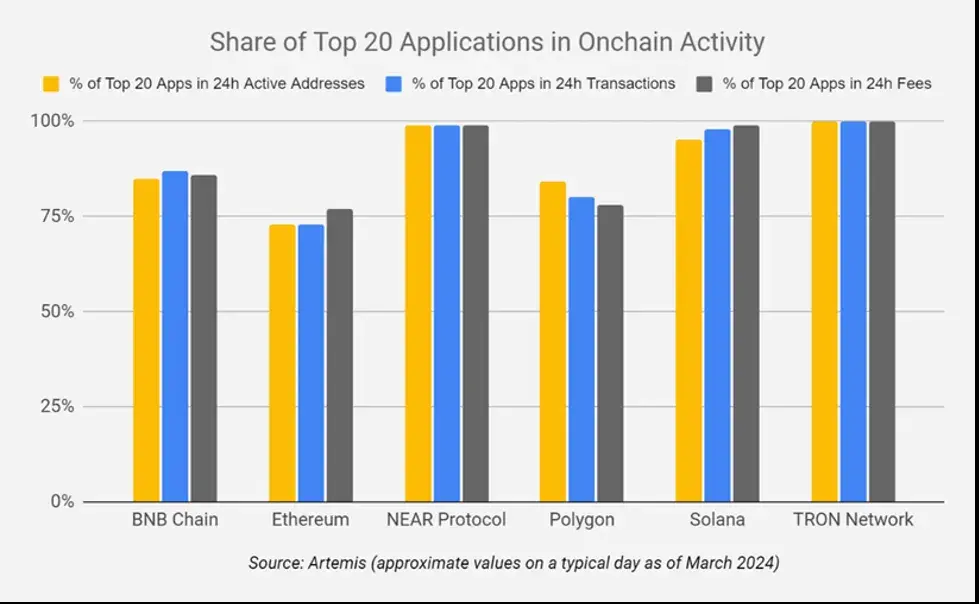
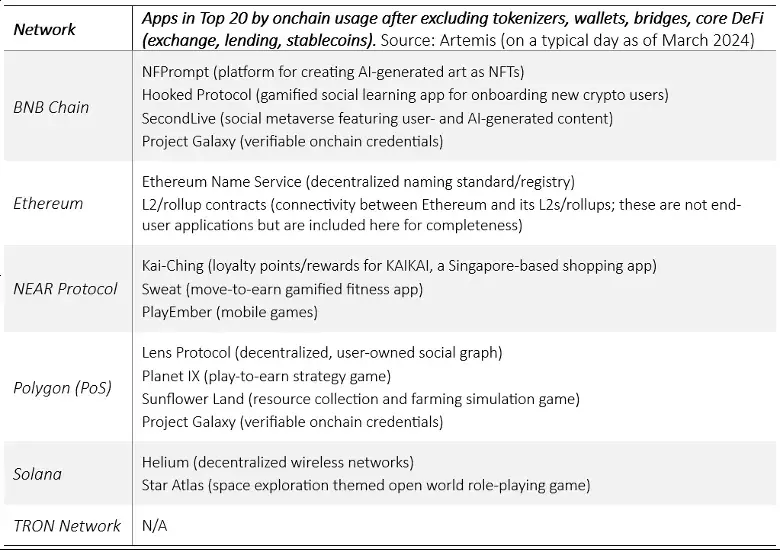
All of the above reflects the legacy of the early development of blockchain and further solidifies its core value proposition as a digital asset ledger. The widespread criticism of blockchain for lacking applications is clearly unfounded, as its primary functions are programmable financialization and the secure settlement of tokenized value. Asset issuance, wallets, DEX (or more broadly, exchanges), lending protocols, and stablecoins have such strong product-market fit simply because they are closely related to this purpose. Given the relatively simple business logic and strong positive feedback loops among these five blockchains, it is not surprising that the leading first-generation smart contract blockchains primarily serve this narrow financial use case. Moreover, since many blockchain applications with non-financial utility ultimately also relate to tokenization and financialization, these five financial applications may continue to dominate the major general-purpose blockchains in the long term.
But what does this mean for the more ambitious vision of blockchain (as a general application platform)? For years, the two biggest challenges facing the crypto industry have been 1) the scalability of blockchains (including throughput and cost), and 2) achieving a simple user experience without sacrificing the decentralization and security guarantees of the underlying infrastructure. In terms of scalability, two approaches are currently commonly adopted: more integrated architectures and more modular architectures, with Solana belonging to the former and Ethereum and its Layer-2 (Rollups) ecosystem showcasing the latter. In practice, these two approaches are not mutually exclusive, and there is considerable overlap and blending between them. But more importantly, depending on whether the application in question needs to share state with other applications and maximize composability, or is less concerned with seamless interoperability but seeks to benefit from complete sovereignty over its governance and economics, both approaches are now mature options for scaling blockchains.
Additionally, we have made significant progress in improving the end-user experience of blockchain applications. Specifically, due to advancements in technologies such as account abstraction, chain abstraction, proof aggregation, and light client verification, there are now several ways to securely eliminate some of the major user experience barriers that have plagued crypto for years, such as the need to securely store private keys or mnemonic phrases, the necessity to pay transaction fees, limitations on account recovery, and excessive reliance on third-party data providers, especially in multi-chain scenarios. Combined with an increasing number of decentralized data storage solutions, verifiable off-chain computation, and other backend services to enhance on-chain application functionality, the current and upcoming application development cycles will determine whether blockchain will play a major role in global financial infrastructure or serve a more general role. Given the vast array of use cases beyond DeFi, these applications will benefit from greater resilience and better user-centered control over data and transactions, such as online identity and reputation, publishing, gaming, wireless and Internet of Things (DePin) physical infrastructure, decentralized science (DeSci), and addressing the growing authenticity issues of AI-generated content. These use cases have always been theoretically attractive, and now they are becoming feasible in practice.










